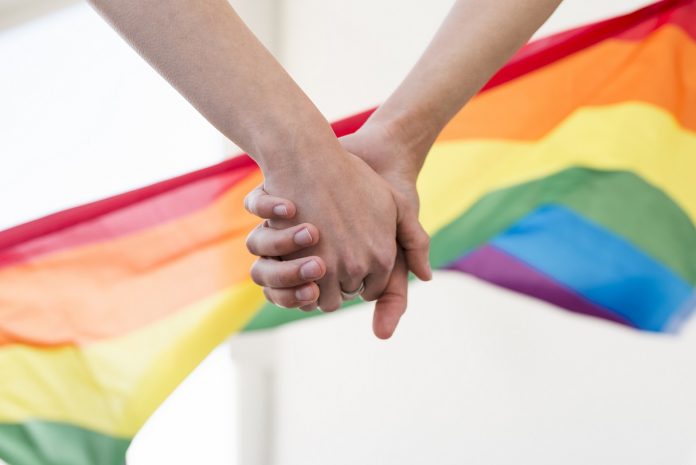This article is written by Aparna Jayakumar, from Guru Gobind Singh Indraprastha University. This article is an analysis of the concept of same-sex marriage with respect to the recent landmark decision by a District Court in Japan.
Table of Contents
Introduction
In March 2021, the Sapporo District Court in Japan declared that the country’s ban on same-sex marriage is ‘unconstitutional’, paving the door for marriage equality in the only G-7 country that does not fully recognize same-sex marriages.
Under Article 24 of the Japanese Constitution, marriage is defined as based on “mutual consent of both sexes,” which is currently construed to indicate that it is permitted only between a man and a woman. One of the case’s plaintiffs Kunimi Ryosuke stated the ruling brought him to tears. “We get used to thinking that prejudice is inherent and that there is nothing we can do about it,” Kunimi Ryosuke said at a news conference hours after the judgment. “We received a strong message today stating that should not happen.”
Based on the premise that Article 24 guarantees the right to heterosexual marriage, the Japanese government has continuously denied the right to same-sex marriage. Furthermore, the Japanese Civil Code and Family Register Act, 1947, relate to marriage criteria between a “husband and wife,” but do not include any prerequisites for same-sex marriage.
The concept of same-sex marriage
Same-sex marriage is the practice of marriage between two men or two women. Though same-sex marriage has been governed by law, religion, and tradition in most nations around the world, legal and societal responses have ranged from celebration to punishment.
Some researchers, most notably Yale professor and historian John Boswell (1947–94), have maintained that same-sex unions were acknowledged by the Roman Catholic Church in medieval Europe, however, this claim has been challenged by others. Scholars and the general public became increasingly interested in the subject throughout the late twentieth century, as views about homosexuality and regulations governing homosexual behavior were liberalized, particularly in Western Europe and the United States.
The question of same-sex marriage has frequently caused emotional and political squabbles between enthusiasts and critics. By the early twenty-first century, many jurisdictions, both national and subnational, have allowed same-sex marriage; in some parts of the world, constitutional provisions were implemented to prohibit same-sex marriages from being sanctioned, or laws were made refusing to recognize such marriages performed elsewhere.
The Swiss legal historian Johann Jakob Bachofen (1861) and the American ethnologist Lewis Henry Morgan (1871) conducted perhaps the first systematic analyses of marriage and kinship; by the mid-twentieth century, such scholars had documented an enormous variety of marriage and sexual customs across cultures.
A brief history
Marriage was not always entirely heterosexual, according to medieval records and artifacts. Since 1989, 23 nations have legalized same-sex relationships, with several permitting full same-sex marriage. Though homosexuality has existed for centuries, the term itself, derived from the Greek homo meaning “same” and the Latin root sex, was invented in 1869 by Karl-Maria Kertbeny. For the majority of the last millennium, Christianity, rather than state law, governed marriages, making Christian attitudes on homosexual unions historically significant. This attitude has been rather ambiguous.
A gravestone in a museum labeled Tomb Slab of an English Couple features all of the traditional iconic symbols of a married couple. Sir William Neville and Sir John Clanvoe are named on the slab (died October 1391). It was discovered during renovations in an Istanbul Dominican church, its existence, location, and symbolism contradicting official doctrine on same-sex unions.
In order to fight the monasteries, Henry VIII passed the Buggery Act of 1533, the first major anti-homosexuality law in England and Ireland (homosexual activity in monasteries was widely documented). Lord Hungerford, the first victim, was executed in 1540. Nonetheless, James I’s bisexuality was a well-kept secret. The last execution took place in 1835, and the death penalty was only replaced with life imprisonment in the 1860s. The contentious “Labouchère Amendment” to the Criminal Law Amendment Act of 1885, which Oscar Wilde was subjected to, stayed in Irish law until 1993.
The modern decriminalization of homosexuality began with the dissolution of ecclesiastical courts in France in 1791. In 1811, the Napoleonic Code was implemented in the Netherlands. In 1932, Catholic Poland abolished the death penalty. Until 1969, West Germany controversially maintained Nazi-enacted anti-gay laws. Following the Wolfenden report, Britain decriminalized in 1967. Only in 1993 did Ireland decriminalize marijuana.
In most of the Western world, attitudes shifted dramatically in the late twentieth and early twenty-first centuries, from criminalization to legal acknowledgment of same-sex partnerships. Only Chechnya criminalises same-sex partnerships today, with the maximum sentence being death. Surprisingly, the Vatican, as a civil state, has no anti-homosexuality legislation.
Denmark was the first country in modern history to legalize same-sex relationships in 1989. Civil unions or registered partnerships are now legal in Norway (1993), Israel (1994), Sweden (1995), Greenland, Hungary, and Iceland (all 1996), France (1999), Germany and Portugal (2001), Finland (2002), Croatia (2003), Luxembourg (2004), the Czech Republic and Slovak Republic (2006).
Across several western nations, the shift from gender-specific to gender-neutral relationships is currently reflected in the form of marriage or civil unions, with many others considering the issue. After removing obstacles to marriage based on religion, class, economic standing, and race, the next to fall is the one that defines marriage solely by gender. It is the most recent development in the millennium-long evolution of marriage.
Japan’s perspective on same-sex marriage
The state’s restrictive view of marriage is a product of the era in which the laws were enacted. In the 1940s, the current Civil Code and the Family Registration Law were both passed. In 2015, Tokyo’s Shibuya and Setagaya wards began distributing certificates to same-sex couples, recognising their partnerships as equivalent to marriage. Though the document is not legally binding, it can allow couples to access the same public facilities as married couples, such as applying for city-run apartments and being recognized as a family in hospitals. Since then, more than 70 more municipalities have followed suit, with over 1,500 couples registering.
Legalizing same-sex marriage in Japan
During the Sapporo trial, plaintiffs’ counsel emphasized that the goal of Article 24 is to ensure gender equality and to prohibit forced marriages and that it does not invalidate the right to same-sex marriage. As a presiding judge, Takebe Tomoko ruled that not allowing same-sex couples to enjoy legal privileges that heterosexual couples can obtain is a breach of Article 14 of the Japanese Constitution, which provides that “all people are equal under the law.”
Furthermore, the “right to life, liberty, and the pursuit of happiness” enshrined in Article 13 was claimed as an additional legal basis by the plaintiffs’ lawyers, but this article may be applicable by analogy rather than legal principle. LGBTQ+ relationships have steadily gained acceptance in Japanese society. A local government law recognising same-sex relationships was introduced in Shibuya Ward of Tokyo in 2015, albeit it is not legally binding. Other municipalities have taken similar steps to recognise same-sex unions.
While there is criticism and caution among the Japanese people regarding the legalization of same-sex marriage, studies have shown up to 80% support for the introduction of same-sex marriage. During the 2016 Upper House election, most members of the ruling Liberal Democratic Party (LDP) appeared to be opposed to the introduction of same-sex marriage, but after extensive internal deliberation, the LDP finally approved an outline of a bill to promote LGBT understanding in a special committee held at the party headquarters in March 2019. Lawmakers will present the bill to the Diet, with the goal of having it passed during the current Diet session. According to the bill’s outline, the bill’s goal is to create a society that can tolerate different sexual orientations and sexual identities. According to the recommended framework, the government should develop a fundamental plan and conduct investigative research. It also encourages businesses to help by providing opportunities for sexual minorities to receive counseling.
The opposition parties’ proposal of a law to ban LGBT discrimination includes consequences for violations, but the LDP’s framework does not. “It is necessary to develop the notion of a society that can tolerate variety before anything else,” said Keiji Furuya, chair of the LDP’s Special Mission Committee on Sexual Orientation and Gender Identity, addressing a gathering of reporters.
Otsuji Kanako, Japan’s first openly lesbian politician and a member of the opposition Constitutional Democratic Party of Japan, was a driving force behind the development of a marriage equality bill in June of that year. While the law proposed by the LDP wants to promote LGBT couples’ understanding, the bill proposed by opposition parties intends to legalize same-sex marriage.
A growing number of LDP politicians, including Kono Taro (minister in charge of coronavirus vaccine deployment), Kawamura Takeo (former education minister), and Noda Seiko (former internal affairs and communications minister), have come out in favour of marriage equality. The right to privacy is also supported by Komeito, the LDP’s coalition government partner, as well as opposition parties.
Last month, Human Rights Watch presented the LDP and other political parties with a petition with 106,250 signatures in support of an LGBT Equality Act, requesting them to legalise same-sex marriage before the Tokyo Olympics and Paralympics Games in July 2021. Indeed, the Olympic Charter outlaws “any kind of discrimination.”
A stepping stone of change
According to the International Lesbian, Gay, Bisexual, Trans, and Intersex Association, around 30 countries and territories around the world have recognized same-sex unions. Taiwan has added to the list two years ago and is still the only country in the region where same-sex couples can marry. Tanamura Masayuki, a law professor at Waseda University and an expert in sexual minority problems, labeled the declaration of unconstitutionality “epoch-making.” “The crucial question was whether the judges would take changes in public opinion and social conditions into account,” he explained.
The current legal standing of Japan with respect to same-sex marriage
One of the recent reports in Japanese Times, in May 2021, envisaged that the bill so in consideration has been approved but after a huge delay due to conservative barriers saying that it would ‘severely affect society’. According to legislators or the Japanese lawmakers, the LDP, which prioritizes developing an understanding of the lesbian, homosexual, bisexual, and transgender population, and the main opposition Constitutional Democratic Party of Japan, which focuses on eradicating discrimination, reconciled their differences through discussions.
The bill includes the phrase “discrimination is unacceptable” among its philosophical objectives, according to the LDP panel’s blueprint. At a party gathering, LDP legislator Kazuo Yana declared that members of the LGBT community were opposed to the maintenance of the species, and that sexual minority couples were not “productive” – comments that attracted criticism from opposition legislators. Marriage is not legally recognized in Japan, despite the fact that a number of towns across the country permit partnerships between members of the LGBT community.
Conclusion
It would be possible for Japan’s lawmakers to alter existing legislation and provide the legal foundation needed to implement a same-sex marriage system. Though constitutional change is desired, it is the most difficult choice and hence not a necessity or a must. Now that the judiciary has delivered a landmark decision, it is up to politicians to take the next step toward legalizing same-sex marriage in Japan and that the Sapporo decision could actually give the marriage equality movement a much-needed boost.
References
- https://www.japantimes.co.jp/news/2015/05/27/national/shibuya-ward-aims-start-issuing-sex-relationship-certificates-october/
- https://www.bbc.com/news/world-asia-56425002
LawSikho has created a telegram group for exchanging legal knowledge, referrals, and various opportunities. You can click on this link and join:
 Serato DJ Crack 2025Serato DJ PRO Crack
Serato DJ Crack 2025Serato DJ PRO Crack










 Allow notifications
Allow notifications



